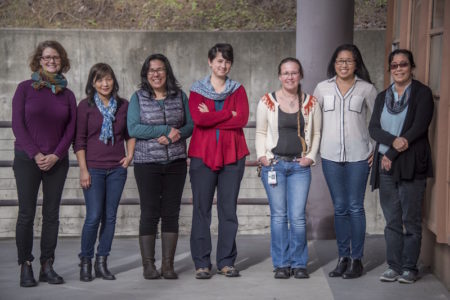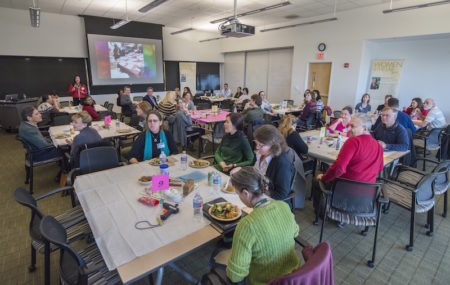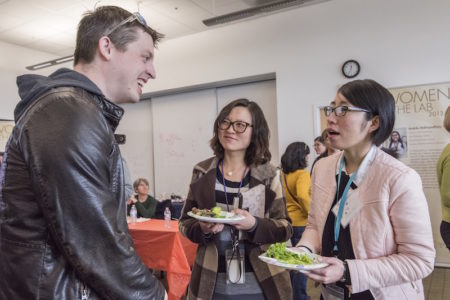
WSEC board members (from left) Elizabeth Stuart, Lauren Lui, Astrid Terry, Katherine Ray, Ina Reichel, Erin Fong and Susan Tsutakawa (Credit: Marilyn Chung/Berkeley Lab)
If you’ve ever used the Lab’s back-up care program or taken a parenting class on your lunch hour, you can thank the Women Scientists & Engineers Council (WSEC). In the eight years since it was formed, it has worked with Human Resources to score a number of accomplishments.
“It’s the small victories that have been really rewarding—getting 20 lactation rooms at the Lab, extension of bereavement leave from five to 10 days, working towards other policy changes,” says Ina Reichel, an ATAP Senior Scientific Engineer Associate who has been involved with WSEC since the early days.
Reichel, who is currently co-chair of WSEC’s policy subcommittee, says that seeing progress in policies that support women at the Lab has kept her interested and involved all these years. Yet there is still much for the group to do.
“The need for WSEC’s efforts is in the numbers—women make up only 15 percent of the scientists and engineers, and that number has basically not changed in the last five years,” says Susan Tsutakawa, current chair of WSEC and a Biochemist Research Scientist/Engineer in the Molecular Biophysics and Integrated Bioimaging Division. “This lack of change is DOE-wide, and that has prompted action from the DOE, with lab directors addressing the challenge of increasing diversity at national labs.”
The WSEC is a program of the Lab’s Diversity and Inclusion Office (DIO) and was founded in 2008 by what longtime members like to call the “founding mothers”—Natalie Roe of the Physics Division, Nancy Brown of the Energy Technologies Area, and Cecilia Aragon, formerly of the Computational Research Division. The council emerged after a conversation between Roe and Vera Potapenko, Berkeley Lab’s recently retired Chief Human Resources and Diversity Officer.
“I recall attending a brown bag discussion in the auditorium that Vera was leading, and raising my hand to bemoan the lack of any women’s groups at the lab,” says Roe, now director of the Physics Division. “The next thing I knew, she followed up with me and said she wanted to establish the WSEC; over the years, she always supported us and offered sincere support for increasing diversity and inclusion at the Lab.”
In the early days, the three WSEC founders looked at retention, recruitment, and professional development for women at the Lab. “We initiated a Lab-wide survey of women scientists, sponsored scientific talks by prominent women scientists, networking events, and a leadership workshop,” says Roe. “With HR support, we also looked closely at the representation of women in various job categories across the Lab.”
In partnership with HR the WSEC has determined priorities and developed strategies for recruitment, retention, work life balance, and empowerment of the Lab’s women scientists and engineers. WSEC members meet regularly with the Lab directorate, and two members sit on the Lab staff and Lab awards committees.
The 64 current members of WSEC are drawn from every division at the Lab, with division directors appointing members. Volunteer members are a large part of the Council’s base as well.
“Many of our accomplishments have benefited both women and men, showing a common need to support scientists and engineers in not only doing their work but also in handling family-related issues that can affect their work,” says Tsutakawa.
In addition to policy, the other two subcommittees focus on empowerment and networking. Elizabeth Stuart, Program Manager in the Electricity Markets and Policy Group, became co-chair of the WSEC networking subcommittee last year.
“I joined because I wanted to find ways to support women’s empowerment here at the Lab, says Stuart. “Our 2016 annual networking event was very well-attended, and it was great to see a lot of men in attendance; one even asked me if men could join the WSEC, to which I answered, ‘of course.’”
Tsutakawa says that the networking events she’s taken part in through WSEC have helped guide her career. Tsutakawa sees the Women@TheLab celebration as another important WSEC contribution, with a website featuring video profiles of women sharing what inspired them to work in science. “The event honors women for their work contributing to the science at Berkeley Lab, and also serves as inspiration for young women who are interested in science and engineering,” she says.
Looking forward, Tsutakawa says recruitment and retention of women are two critical areas the WSEC has identified. “It’s all really intertwined with our work because in order to retain women we need funding, and the way we get funding for women is by empowering women and giving them the skills they need to obtain that funding,” she says.
A third area where the Council is focusing efforts is “family friendly” policies, such as paid parental leave, childcare, “stop the clock” (which gives employees extra time to reach tenure, or go from term to staff scientist after they’ve taken extended time off), and pay parity.
Erin Fong, a postdoc in the Engineering Division, joined WSEC last year after a networking event drew her in. Since then she’s found the Council to be a trusted source for leadership and career development. “When I’ve had questions, it’s been great to be able to turn to someone in the WSEC, especially when learning about career paths at the Lab,” Fong says. “Being part of the Council has empowered me and affected my work positively.”
HOW TO JOIN: Sign up to join WSEC here.





Maybe someday Berkeley Lab can address the 2-body problem, and the number of scientific spouses here who struggle to stay in science. UC Berkeley does, why doesn’t LBL?
http://ofew.berkeley.edu/partner-hiring-program-guidelines-and-procedures